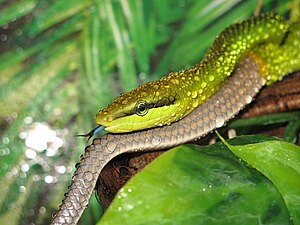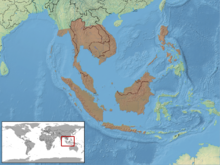Pointed snake
| Pointed snake | ||||||||||||
|---|---|---|---|---|---|---|---|---|---|---|---|---|

Pointed head or red tailed snake ( Gonyosoma oxycephalum ) |
||||||||||||
| Systematics | ||||||||||||
|
||||||||||||
| Scientific name | ||||||||||||
| Gonyosoma oxycephalum | ||||||||||||
| ( Boie , 1827) |
The pointed head snake ( Gonyosoma oxycephalum ), also known as the red-tailed snake or green snake , is a species of reptile from the snake family (Colubridae).
In the past, the pointed head snake, like the corn snake , the Aesculapian snake or the leopard snake , was placed in the genus Elaphe . Today, however, it is classified in the genus Gonyosoma with its relatives Gonyosoma hodgsoni , G. cantoris and G. frenatum . The pointed head snake is non-toxic .
features
The females usually grow to 170, rarely up to 240 cm, while the males remain somewhat smaller. The snake has a basic color that can range from green-yellow to olive. The bottom is usually lighter than the top. The tail is reddish-brown and sharply contrasted in color, which is also indicated by the German name "Rotschwanznatter" and the English name "Red-tailed Green Ratsnake". The pointed head snake has a black eye band and a round pupil . The tongue , which is usually black and forked as in all snakes, can have a blue border.
This adder, due to its mainly arboreal way of life, has developed strong and rough scales on its top surface that are helpful when climbing trees. The black pattern on these scales is different depending on the individual. The pointed head snake has 23-27 dorsal rows of scales in the middle of the body and 8 to 11 supralabials ( scutum supralabiale ), of which 2 usually touch the eye socket ( orbit ). The anal scale ( scutum anale ) is divided. It has an average of 245 (240–249) pre- caudal , i.e. vertebrae lying in front of the tail.
distribution

The pointed head snake is a Southeast Asian species of snake and is widespread. Their distribution area ranges from Myanmar to Indonesia to the Philippines . Their type locality is Java .
Way of life and habitat
The pointed head snake is diurnal and lives exclusively on trees in the rainforest , especially near bodies of water and mangrove swamps. The snake is very aggressive. If it is disturbed, it usually bites immediately. When excited, the tail of the pointed head snake is constantly in motion.
Diet and predators
In the wild, the pointed head snake feeds primarily on tree-dwelling mammals and bats. It can even catch small birds from the air because of its speed. The prey animals are killed by being entangled. Their predators are mainly the serpent harriers ( Spilornis ). In the event of danger, the pointed head snake can inflate its neck , possibly through the large tracheal lung, which should make it appear larger.
Reproduction
The information on reaching sexual maturity of these animals vary between 2 years and 4 years. The pointed head snake is oviparous , it lays 5–12 cylindrical eggs between September and January . The young animals hatching after 95–125 days are 45 cm long and 20–25 g in weight at the time of hatching . In the first months of life, the young snakes feed on small lizards and frogs.
Keeping in terrariums
The pointed head snake is often kept in terrariums. This species is also common in zoos. This type of viper can live up to 15 years in captivity.
The young pointed-headed snakes eat young, naked mice in captivity , while the adult animals prefer to eat adult mice, chicks and small rats .
Photo gallery
literature
- Friedrich Boie: Comments on Merrem's attempt at a system of amphibians . In: Isis von Oken . tape 20 , 1827, pp. 508-566 ( biodiversitylibrary.org ).
swell
- ↑ a b c d e f Schmidt, Dr. Dieter: Atlas of the snakes . bede-Verlag, 2001. ISBN 3-933646-96-0
- ↑ a b c d e Mehrtens, John M .: Snakes of the world . Franckh-Kosmos, 1993: page 105. ISBN 3-440-06710-6
- ↑ a b Urs Utiger, Beat Schätti, Notker Helfenberger: The oriental Colubrine Genus Coelognathus FITZINGER, 1843 and classification of old and new world racers and ratsnakes (Reptilia, Squamata, Colubridae, Colubrinae) . In: Russian Journal of Herpetology Vol. 12, No. 1, 2005, pp. 39-60. ( Online ( page no longer available , search in web archives ) Info: The link was automatically marked as defective. Please check the link according to the instructions and then remove this notice .; PDF; 293 kB)
- ↑ a b c d e Henkel, FW; Schmidt, W .: Pocket Atlas Reptiles . Ulmer Verlag, 2007: page 143. ISBN 978-3-8001-5158-5
Web links
- Gonyosoma oxycephalum in The Reptile Database
- Gonyosoma oxycephalum inthe IUCN Red List of Threatened Species 2013.1. Posted by: Wogan, G., Vogel, G., Thy, N., Nguyen, TQ, Demegillo, A., Diesmos, AC & Gonzalez, JC, 2011. Retrieved September 23, 2013.





